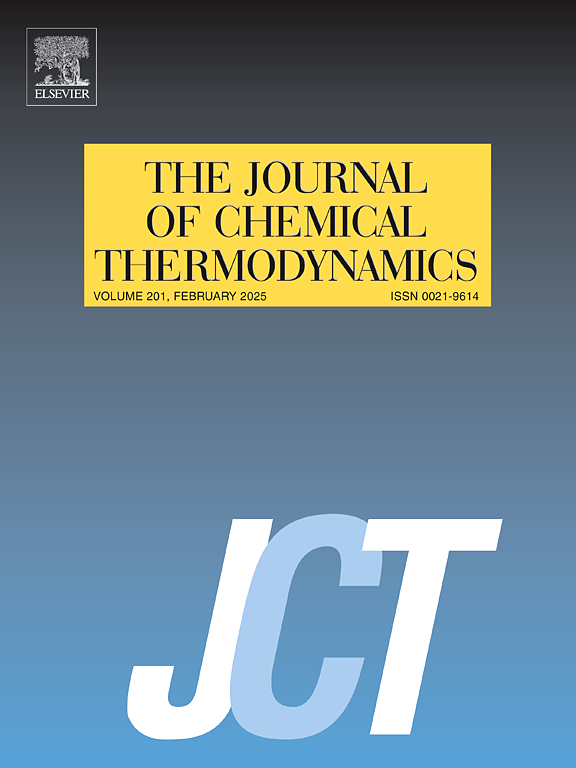低压下2-苯乙醇 + 正庚烷混合物LLE、VLE、运动粘度和密度的建模和实验数据
IF 2.2
3区 工程技术
Q3 CHEMISTRY, PHYSICAL
引用次数: 0
摘要
2-苯乙醇(2-PE)广泛用于食品和制药工业,以提高溶解度和抗菌性能。它在石油工业中的应用正在扩大,在石油工业中,它作为燃料添加剂,在火花点火发动机中提高汽油的抗爆性能,并作为低反应性燃料。对这种混合物的适当描述允许对工业过程进行模拟和优化,这在过程性能的设计和评估中是重要的。本工作提供了85 kPa下2-PE +正庚烷(nC7)混合物的实验数据和模型。报告了相平衡数据和输运性质,如密度、液-液平衡(LLE)温度、气-液平衡(VLE)和运动粘度。LLE和VLE数据覆盖的温度范围分别为294.49 K ~ 306.75 K和366.58 K ~ 485 K。实验数据采用改进的Peng-Robinson (PR)状态方程(EoS)和Huron-Vidal混合规则与NRTL活度系数模型进行建模。结果表明,密度、LLE和VLE的平均绝对相对偏差分别为1.87 %、0.26 %和0.07 %。此外,使用Grunberg和Nissan以及Eyring-Wilson-Porter混合规则对动态粘度进行估计和建模,平均绝对相对偏差范围为2.25 %至2.33 %。本文章由计算机程序翻译,如有差异,请以英文原文为准。

Modeling and experimental data of LLE, VLE, kinematic Viscosity, and density for the 2-Phenylethanol + n-Heptane mixture at low pressure
2-Phenylethanol (2-PE) is widely used in the food and pharmaceutical industries to enhance solubility and antimicrobial properties. Its application is expanding in the oil industry, where it functions as a fuel additive, improving the anti-knock properties of gasoline in spark-ignition engines and acting as a low-reactivity fuel. The appropriate description of this mixture allows the simulation and optimization of the industrial processes, which is important in the design and evaluation of the performance of the processes. This work provides experimental data and modeling of the 2-PE + n-heptane (nC7) mixture at 85 kPa. Phase equilibrium data and transport properties such as density, liquid–liquid equilibrium (LLE) temperature, vapor–liquid equilibrium (VLE), and kinematic viscosity are reported. The LLE and VLE data cover temperature ranges from 294.49 K to 306.75 K and 366.58 K to 485 K, respectively. The experimental data were modeled using the modified Peng-Robinson (PR) Equation of State (EoS) and the Huron-Vidal mixing rule with the NRTL activity coefficient model. Interaction parameters were estimated, and the results showed that the average absolute relative deviations were 1.87 % for density, 0.26 % for LLE, and 0.07 % for VLE. Also, dynamic viscosity was estimated and modeled using the Grunberg and Nissan, and Eyring-Wilson-Porter mixing rules, with average absolute relative deviations ranging from 2.25 % to 2.33 %.
求助全文
通过发布文献求助,成功后即可免费获取论文全文。
去求助
来源期刊

Journal of Chemical Thermodynamics
工程技术-热力学
CiteScore
5.60
自引率
15.40%
发文量
199
审稿时长
79 days
期刊介绍:
The Journal of Chemical Thermodynamics exists primarily for dissemination of significant new knowledge in experimental equilibrium thermodynamics and transport properties of chemical systems. The defining attributes of The Journal are the quality and relevance of the papers published.
The Journal publishes work relating to gases, liquids, solids, polymers, mixtures, solutions and interfaces. Studies on systems with variability, such as biological or bio-based materials, gas hydrates, among others, will also be considered provided these are well characterized and reproducible where possible. Experimental methods should be described in sufficient detail to allow critical assessment of the accuracy claimed.
Authors are encouraged to provide physical or chemical interpretations of the results. Articles can contain modelling sections providing representations of data or molecular insights into the properties or transformations studied. Theoretical papers on chemical thermodynamics using molecular theory or modelling are also considered.
The Journal welcomes review articles in the field of chemical thermodynamics but prospective authors should first consult one of the Editors concerning the suitability of the proposed review.
Contributions of a routine nature or reporting on uncharacterised materials are not accepted.
 求助内容:
求助内容: 应助结果提醒方式:
应助结果提醒方式:


